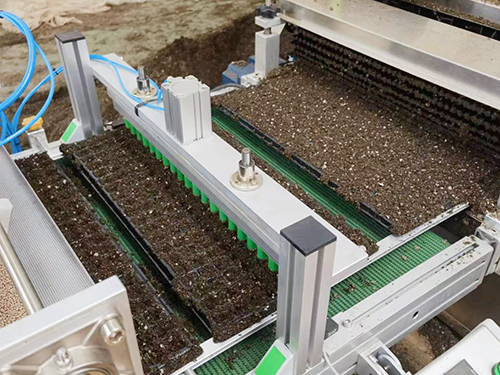Maintenance and Care Tips for Seedling Tray Seeders
2024-09-01 13:52:12
Seedling tray seeders play a vital role in modern agriculture and horticulture by significantly enhancing seeding efficiency and crop quality. To ensure their long-term stable operation and optimal performance, regular maintenance and care are essential. This article outlines detailed maintenance and care tips for seedling tray seeders, helping you extend the equipment’s lifespan and improve its working efficiency.

1. Why Maintenance and Care Are Necessary
1.1. Extend Equipment Lifespan
Regular maintenance and care effectively reduce wear and tear on the equipment, extending the seeder’s service life. Good maintenance practices help avoid downtime and repair costs caused by equipment failures.
1.2. Ensure Seeding Precision
The precision of the seeding machine directly affects seed distribution and crop growth. Regular maintenance ensures that all parameters and functions of the seeder are operating correctly, ensuring seeding accuracy and consistency.
1.3. Reduce the Likelihood of Failures
Regular checks and maintenance can identify potential issues early, preventing small problems from escalating into major faults. Preventive maintenance reduces the occurrence of unexpected failures and enhances equipment reliability.
1.4. Improve Operational Efficiency
Properly maintained equipment ensures efficient seeding operations. Good maintenance practices can minimize equipment downtime and failure rates, thereby improving overall production efficiency.
2. Maintenance and Care Tips for Seedling Tray Seeders
2.1. Regular Cleaning
Remove Seed Residue: After each use, promptly clean any seed residues and debris from the interior of the seeder. Seed residues, especially in the seed supply system and seeding mechanisms, can affect seeding performance and equipment operation.
Clean External Parts: Use soft cloths or brushes to clean the external parts of the seeder. Avoid using strong acids or alkalis to prevent damage to the equipment's surface.
Check Filters: Regularly inspect and clean the filters in the seed supply system to ensure they are clear and prevent blockages caused by seeds or debris.
2.2. Inspect and Tighten Components
Check Screws and Nuts: Regularly check the screws and nuts on the seeder to ensure they are secure. Loose components can lead to unstable operation or equipment malfunctions.
Tighten Connecting Parts: Inspect the tightening of connection parts in the conveyor system and seeding mechanism to avoid connection issues caused by vibration or wear.
2.3. Lubricate Moving Parts
Add Lubricant: Regularly add the appropriate amount of lubricating oil to moving parts such as conveyor belts and seeding heads to reduce friction and wear.
Inspect Lubrication System: If the seeder is equipped with an automatic lubrication system, periodically check its operation to ensure the proper supply of lubricating oil.
2.4. Adjust Seeding Parameters
Check Seeding Density and Spacing: Regularly check and adjust the seeding density and spacing settings to meet actual needs. Adjust the parameters according to crop type and tray specifications to ensure seeding accuracy.
Calibrate Seeding Mechanism: For devices that require precise control of seeding quantity, periodically calibrate the seeding mechanism to ensure it operates according to set standards.
2.5. Inspect Electrical System
Check Cables and Connectors: Regularly inspect the seeder's cables and connectors for any damage or looseness. Electrical system faults can prevent the equipment from functioning correctly.
Test Control System: Periodically test the seeder’s control system to ensure all functions are operational. Check if the display screen and operation buttons respond promptly to avoid operational errors.
2.6. Storage and Protection
Proper Storage: During off-seasons, store the seeder in a dry, well-ventilated area. Avoid exposure to moisture or extreme temperatures to prevent equipment damage.
Cover Protection: Use protective covers or coverings to shield the seeder from dust, moisture, and other environmental factors. Protective covers can effectively reduce external damage to the equipment.
2.7. Professional Maintenance
Regular Inspection: Follow the manufacturer’s recommendations for regular professional inspections. Technicians can conduct comprehensive checks and maintenance to ensure the seeder's long-term stable operation.
Replace Worn Parts: Replace parts that are severely worn or damaged in a timely manner. Using original factory parts ensures the equipment’s performance and quality.
3. Conclusion
Maintaining and caring for seedling tray seeders is crucial for ensuring the equipment’s long-term stable operation and efficient performance. By regularly cleaning, inspecting, lubricating, adjusting seeding parameters, checking the electrical system, storing properly, and performing professional maintenance, you can effectively extend the seeder's lifespan, improve seeding precision, and enhance work efficiency. Good maintenance practices not only reduce the likelihood of failures but also boost overall production efficiency, leading to higher-quality crop cultivation.

The CNC Seed Braiding Machine is a high-precision, fully automated agricultural equipment s...

It adopts electrical integration and can be started by pressing the fully automatic button ...

The XP750 seeder has stable performance, excellent product quality, simple and convenient o...

It adopts electrical integration and can be started by pressing the fully automatic button ...



